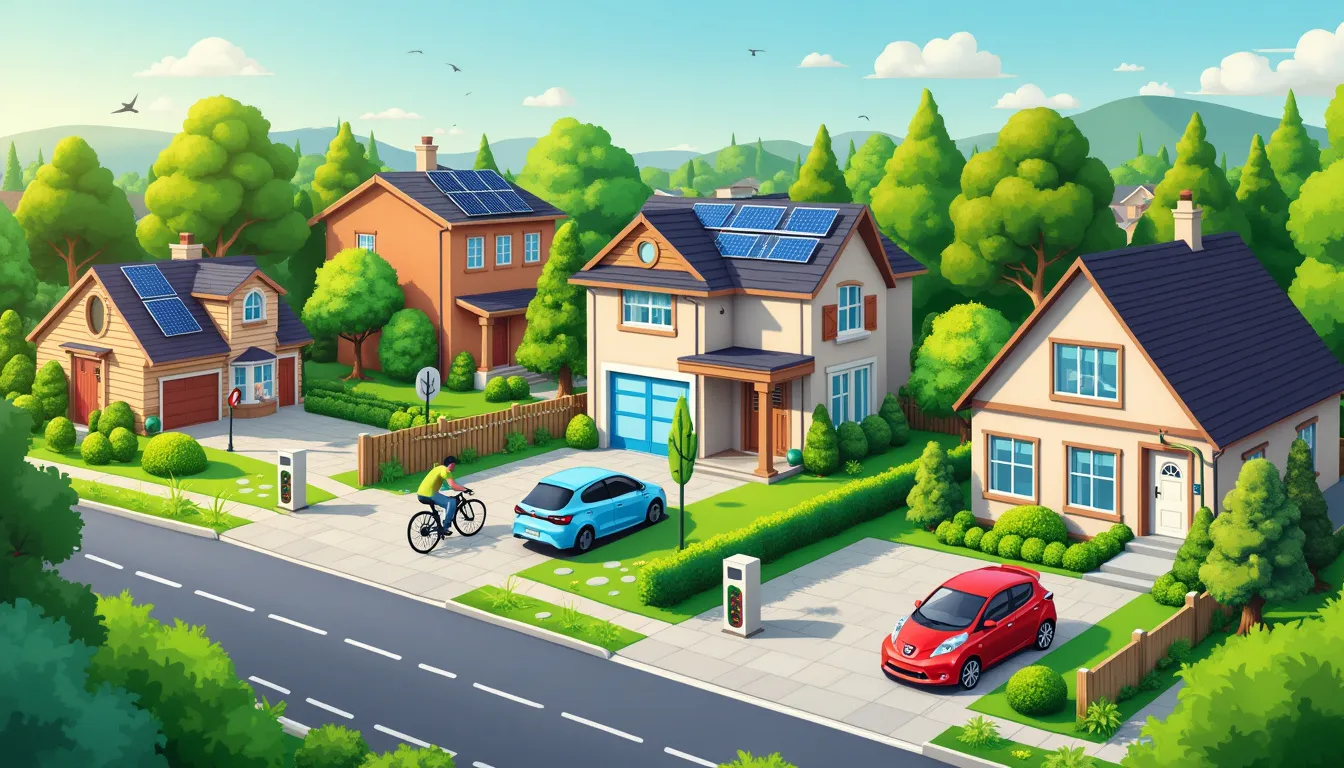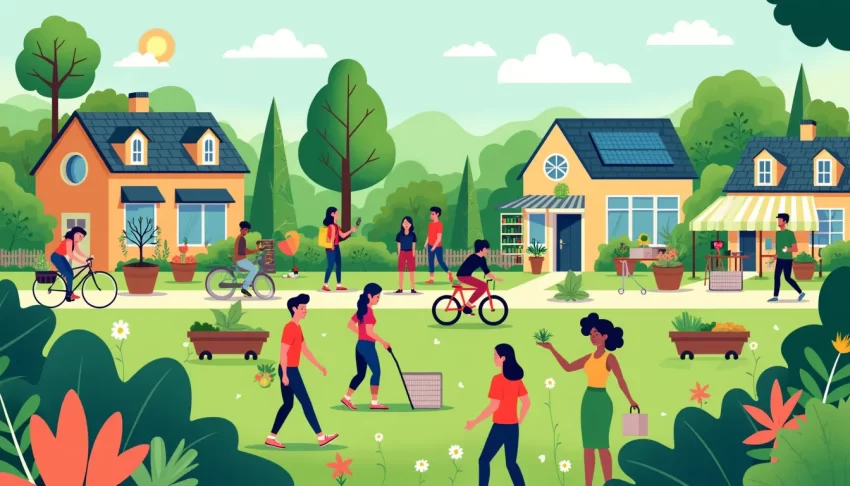Living an eco-friendly lifestyle isn’t just a trend; it’s a vital practice for preserving our planet and improving our personal well-being. The urgency to adopt sustainable habits has never been more pressing. With climate change accelerating and our natural resources depleting at alarming rates, every small step towards sustainability can make a significant impact. Embracing an eco-friendly lifestyle not only benefits the environment but also enhances our quality of life, from reducing exposure to toxins to saving money on energy bills.
Whether you’re just starting your sustainability journey or looking for more ways to incorporate green practices into your routine, this guide is packed with practical tips to help you make a difference. We’ll explore ten easy ways to live more sustainably, showing that even simple daily habits like reducing single-use plastics, conserving water, and minimizing energy use can collectively drive tremendous positive change. You’ll also discover how eco-friendly choices in food and shopping can support local economies and reduce our carbon footprint.
Moreover, we’ll delve into sustainable practices in transportation and home upgrades, highlighting innovative solutions like using public transport or carpooling, and investing in energy-efficient home technologies. By adopting these ten easy eco-friendly practices, you can contribute to a healthier planet and a more sustainable future, all while enjoying the personal benefits of a greener lifestyle. Let’s dive into a journey towards sustainability that’s as feasible as it is impactful.
Introduction to an Eco-Friendly Lifestyle
Adopting an eco-friendly lifestyle isn’t just a trend; it’s an urgent necessity. With climate change accelerating and natural resources depleting at unprecedented rates, the onus falls on each of us to make sustainable choices. But what does it mean to lead an eco-friendly lifestyle, and why should it matter to you?
Importance of Adopting an Eco-Friendly Lifestyle
Living eco-friendly means incorporating practices that reduce your environmental impact, helping to preserve the planet for future generations. The main focus is on creating sustainable habits that minimize waste, conserve resources, and enhance overall well-being.
The environmental benefits are clear. Each step you take, from reducing single-use plastics to minimizing energy consumption, contributes to a larger, collective impact. According to the EPA (Environmental Protection Agency), improved sustainability practices have the potential to significantly cut greenhouse gas emissions, reduce pollution, and slow the effects of climate change. But the advantages aren’t just ecological; they’re personal, too.
Benefits for the Environment and Personal Well-Being
Adopting an eco-friendly lifestyle can also lead to tangible benefits for your health and wallet. For instance, consuming organic and locally grown foods not only reduces your carbon footprint but also introduces fewer pesticides into your diet, contributing to better health. Replacing disposable items with reusable ones might require a small initial investment, but it saves money in the long run.
Furthermore, sustainable practices often encourage a more mindful way of living. By focusing on the impact of your choices, you’re more likely to develop habits that enhance your overall well-being. For example, walking or biking instead of driving not only lowers your carbon emissions but also increases your physical activity, promoting better fitness.
Brief Overview of the 10 Easy Ways to Be Detailed
So, how can you integrate these practices into your daily life without feeling overwhelmed? The good news is that sustainability doesn’t have to be complicated. Here are ten easy ways to lead an eco-friendly lifestyle, which we’ll delve into further:
- Reducing single-use plastics: Reusable bags, bottles, and containers.
- Conserving water: Fixing leaks, using water-saving appliances.
- Minimizing energy use: Switching to LED bulbs, unplugging devices.
- Eating locally and seasonally: Supporting local farmers and reducing carbon footprints.
- Opting for organic and sustainably sourced products.
- Reducing food waste: Meal planning and proper storage techniques.
- Using public transportation, biking, or walking.
- Carpooling and using electric or hybrid vehicles.
- Eco-friendly home upgrades: Solar panels, energy-efficient appliances.
- Engaging in community sustainability projects: Local clean-ups, community gardens.
By focusing on these areas, you’re setting yourself up for success in making more sustainable choices. The path to a greener lifestyle is about taking small, manageable steps that collectively make a significant difference. Whether you’re an individual or a business owner, these changes are within your reach and can positively impact both the planet and your well-being. Stay tuned as we break down these ten tips into actionable steps that you can incorporate into your daily routine.

Simple Daily Habits for an Eco-Friendly Lifestyle
Reducing Single-Use Plastics: Reusable Bags, Bottles, and Containers
Incorporating simple changes in your daily routine can have a significant impact on the environment. One effective way is by reducing single-use plastics. Single-use plastics such as straws, bags, and bottles account for a large portion of pollution and environmental degradation. Fortunately, there’s an accessible solution: reusable bags, bottles, and containers.
Consider making a habit of carrying a reusable bag when you go shopping. Not only are they sturdier than plastic bags, but they also reduce the amount of plastic waste that ends up in landfills and oceans. A study by the United Nations Environment Programme (UNEP) revealed that plastic bags have a devastating impact on wildlife and ecosystems. By switching to reusable alternatives, you help protect marine life.
Similarly, investing in a high-quality reusable water bottle can drastically cut down on the usage of disposable plastic bottles. Brands like Hydro Flask and S’well offer durable bottles that keep your beverages at the desired temperature and are perfect for daily use. This small habit saves money and reduces plastic pollution.
Reusable containers can also be a game-changer in reducing plastic waste. Swap your single-use sandwich bags and plastic wrap for silicone food storage bags and beeswax wraps. These alternatives are not only environmentally friendly but often preserve food better, keeping it fresh and safe to eat for longer periods.
Conserving Water: Fixing Leaks, Using Water-Saving Appliances
Water is a precious resource, and conserving it is an essential part of leading an eco-friendly lifestyle. Simple habits such as fixing leaks and using water-saving appliances can make a big difference.
Start by inspecting your home for any leaky faucets or pipes. Even a small drip can waste a significant amount of water over time. According to the U.S. Environmental Protection Agency (EPA), a leaky faucet that drips at the rate of one drip per second can waste over 3,000 gallons of water per year. Fixing these leaks not only conserves water but also saves on your water bill.
Incorporating water-saving appliances in your home is another effective strategy. Consider installing low-flow showerheads and faucet aerators, which can reduce water use by up to 50% without sacrificing water pressure. Additionally, opting for a dual-flush toilet can save significant amounts of water with each flush. These appliances are designed to be efficient and provide the same performance as their traditional counterparts.
Another practical tip is being mindful of your water use in daily activities. For example, taking shorter showers, turning off the tap while brushing your teeth, and only running the dishwasher and washing machine with full loads can easily become part of your routine. These small changes collectively contribute to substantial water conservation.
Minimizing Energy Use: Switching to LED Bulbs, Unplugging Devices
Reducing energy consumption is another critical component of an eco-friendly lifestyle. Simple adjustments like switching to LED bulbs and unplugging devices when not in use can lead to significant energy savings and reduced carbon footprints.
LED bulbs are far more energy-efficient compared to traditional incandescent bulbs. They use up to 80% less energy and can last up to 25 times longer, according to Energy.gov. By replacing your home’s light bulbs with LEDs, you can significantly cut down on energy use and reduce your electricity bill. Plus, LED bulbs are available in various color temperatures and brightness levels, ensuring you don’t have to compromise on the quality of light in your living spaces.
Unplugging devices when not in use is another straightforward method to conserve energy. Many electronics consume power even when turned off, a phenomenon known as phantom load or vampire power. The U.S. Department of Energy estimates that this standby power can account for up to 10% of an average household’s electricity use. Simple actions like unplugging chargers, TVs, and kitchen appliances when they’re not being used can prevent this unnecessary energy drain.
Using power strips with on/off switches can make this task more manageable, especially for clustered electronics. This way, you can easily cut power to multiple devices with a single flip of a switch.
Additionally, consider these energy-saving habits: setting your thermostat a few degrees lower in winter and a few degrees higher in summer, air-drying clothes instead of using a dryer, and using energy-efficient appliances. Each of these habits, although seemingly small, can substantially reduce your overall energy consumption.
By adopting these simple daily habits – reducing single-use plastics, conserving water, and minimizing energy use – you can make a significant impact on the environment. These changes not only contribute to a healthier planet but also promote personal well-being, creating a more sustainable and fulfilling lifestyle.

Eco-Friendly Choices in Food and Shopping
When it comes to adopting an eco-friendly lifestyle, one of the most impactful areas you can focus on is your food and shopping habits. The choices we make at the grocery store and farmer’s market, as well as the way we handle food at home, have significant repercussions on the environment. Here’s how you can make more sustainable choices in food and shopping:
Eating Locally and Seasonally
Supporting local farmers and consuming seasonally grown produce is a powerful way to reduce your carbon footprint. When you buy locally, you’re not only getting fresher, more nutritious food, but you’re also cutting down on the greenhouse gas emissions associated with long-distance transportation. Visit local farmers’ markets or subscribe to a community-supported agriculture (CSA) program to get a steady supply of seasonal fruits and vegetables. For instance, strawberries in the summer or winter squash in the colder months are both delicious and eco-friendly choices.
Opting for Organic and Sustainably Sourced Products
Choosing organic and sustainably sourced products means you’re supporting farming practices that are better for the environment. Organic farming typically avoids synthetic fertilizers and pesticides, which can harm wildlife and contaminate water sources. Additionally, look for products labeled Fair Trade or Rainforest Alliance Certified. These labels indicate that the products were produced with a focus on sustainability, fair labor practices, and responsible land use. For example, Fair Trade coffee or chocolate ensures that the farmers are paid fairly and that eco-friendly farming methods are used.
Reducing Food Waste
Food waste is a significant environmental issue; about one-third of all food produced globally is wasted. To combat this, meal planning and proper storage techniques can go a long way. Before you shop, create a weekly meal plan and stick to your grocery list to avoid buying unnecessary items. Store your produce properly to extend its shelf life—keeping herbs in water or using breathable produce bags are just a couple of techniques. Additionally, get creative with leftovers: turn yesterday’s roasted veggies into today’s hearty soup, or use fruit that’s slightly past its prime to make smoothies or baked goods.
To sum up, incorporating these eco-friendly choices in your food and shopping practices can make a tremendous difference. By eating locally and seasonally, opting for organic and sustainably sourced products, and reducing food waste, you can enjoy delicious meals while doing your part for the planet.

Sustainable Practices in Transportation and Home
Adopting an eco-friendly lifestyle extends beyond daily habits and into how we move around and live in our homes. Transportation and home energy use are major contributors to our carbon footprint, but by making intentional and informed choices, we can significantly reduce our impact.
Using Public Transportation, Biking, or Walking
Transportation is responsible for a significant portion of greenhouse gas emissions. For example, in 2019, the U.S. Environmental Protection Agency reported that the transportation sector accounted for 29% of total U.S. greenhouse gas emissions. One way to combat this is by opting for sustainable transportation methods.
Public transportation, such as buses, trains, and subways, is an efficient way to reduce individual carbon footprints. A single bus can replace dozens of cars on the road, decreasing overall emissions.
Biking and walking are not only eco-friendly but also beneficial for personal health. These modes of transport produce zero emissions and can significantly improve cardiovascular health. For instance, a study by the British Journal of Sports Medicine found that individuals who biked to work had a lower risk of cardiovascular disease compared to those who drove.
Embracing these alternatives could mean a shift in daily routines, but they offer the dual benefits of reducing emissions and enhancing personal well-being. Consider integrating them into your life by setting small, achievable goals like committing to public transportation once a week or biking to nearby destinations.
Carpooling and Using Electric or Hybrid Vehicles
For many, driving is a necessity. However, carpooling is an excellent way to lessen the environmental impact of driving. By sharing rides with coworkers, friends, or family members, you’re reducing the number of vehicles on the road, which in turn lowers emissions and traffic congestion. According to the American Public Transportation Association, carpooling can significantly cut down on fuel use and emissions.
If you’re in the market for a new vehicle, consider investing in an electric or hybrid car. These vehicles are designed to be more energy-efficient and produce fewer emissions compared to traditional gasoline-powered cars. For instance, an electric vehicle (EV) produces about half the emissions of a conventional car over its lifetime, according to the Union of Concerned Scientists.
Additionally, the cost savings are notable. Although electric vehicles tend to have a higher upfront cost, they often require less maintenance and lower fuel costs, resulting in long-term savings. Many regions also offer incentives, such as tax credits and rebates, for purchasing electric or hybrid cars.
Eco-Friendly Home Upgrades: Solar Panels, Energy-Efficient Appliances
Your home is another significant area where sustainable practices can make a difference. Implementing eco-friendly upgrades can drastically cut energy consumption and reduce utility bills.
Solar Panels
Solar panels are an excellent renewable energy source. They convert sunlight into electricity, allowing you to power your home sustainably. While the initial investment can be high, the long-term benefits include reduced energy bills and less reliance on fossil fuels. Plus, many governments offer incentives and rebates to help offset the cost of installation.
Installing solar panels can also increase your home’s value. According to a study by the Lawrence Berkeley National Laboratory, homes with solar panels sold for about 4.1% more than those without.
Energy-Efficient Appliances
Switching to energy-efficient appliances is another effective way to create an eco-friendly home. Appliances with ENERGY STAR certification, for instance, meet strict energy efficiency guidelines set by the U.S. Environmental Protection Agency. These appliances use less electricity and water compared to traditional models, leading to lower utility bills and reduced environmental impact.
For example, an ENERGY STAR certified refrigerator uses about 15% less energy than non-certified models, and an energy-efficient washing machine can save up to 25% on energy and 33% on water.
Other simple upgrades include installing programmable thermostats, which allow you to set your home’s temperature according to your daily schedule, and using low-flow showerheads and toilets to conserve water.
By adopting sustainable practices in transportation and making eco-friendly upgrades at home, you contribute to a healthier environment and promote long-term sustainability. These changes, whether big or small, all add up to significant impacts over time.
As we navigate the path towards a more eco-friendly lifestyle, it’s clear that even the smallest changes in our daily routines can have a significant impact on both our environment and our overall well-being. Adopting eco-friendly habits doesn’t require major life changes or extensive investments. By taking simple, mindful steps as outlined in this guide—such as reducing single-use plastics, conserving water, and minimizing energy use—we can collectively drive substantial progress toward a sustainable future.
Incorporating eco-friendly choices into our diets and shopping habits further emphasizes the importance of conscious consumption. By eating locally and seasonally, opting for organic and sustainably sourced products, and taking steps to reduce food waste, we are not only promoting environmental health but also supporting our local economies and improving our personal health.
Our approach to transportation and our homes plays a pivotal role too. Embracing public transportation, biking, walking, carpooling, and considering electric or hybrid vehicles can drastically cut down our carbon footprint. Additionally, making eco-friendly upgrades at home—like installing solar panels and using energy-efficient appliances—can lead to long-term environmental and financial benefits.
The journey to an eco-friendly lifestyle is a rewarding one, filled with opportunities to make a positive difference. Every effort counts, and when combined, our collective actions can lead to substantial change. By making conscientious choices and encouraging others to do the same, we’re not only safeguarding our planet for future generations but also creating healthier, more connected communities.
So, let’s take these steps towards sustainability seriously, embracing the eco-friendly lifestyle not as a fleeting trend but as a permanent, vital shift in how we live and interact with our world. Whether you’re an individual making small adjustments or a business looking to implement greener practices, every action adds up. Start with the tips and practices shared here, and continue to seek out new ways to contribute to a greener, more sustainable future. Let’s inspire one another and be the change we wish to see—for ourselves, for our communities, and for the planet.
Support Us: Check out our recommended products on Amazon.

